Creating makeup effects requires a number of skill sets, including lifecasting, sculpture, mold making, and appliance casting and application techniques.
In most professional settings, the skill sets needed for creating a character makeup are most often practiced individually because each requires a good deal of concentrated expertise; however, it is not uncommon to find individuals who are adept at wearing the many hats necessary to take a project from concept to completion by themselves.
Once a negative mold/lifecast has been created, it must be immediately filled with a gypsum stone material called Ultracal 30 to make a positive from the alginate negative.
It is important that this be done very soon after the alginate mold is completed, because it will begin to dry out almost immediately. If your positive is not a precise copy of your subject, the finished appliance will not fit properly when it is applied to your subject later.
Ultracal 30 is similar to plaster but much harder when fully cured. I sometimes refer to it as Plaster-zilla. The form of the prosthetic appliance is sculpted in oil/wax clay on top of the newly cast positive after the positive has been cleaned
up.


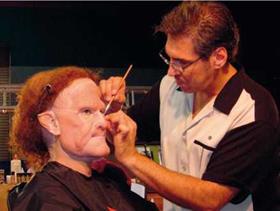
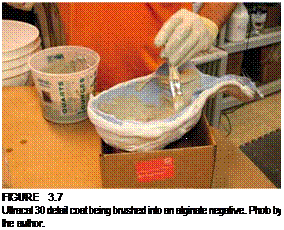 It is very important that the edges of the clay be made as thin as possible to create an invisible edge; the clay is a stand-in for what will eventually be the foam latex (or silicone, urethane, or foamed gelatin) piece, and only thin edges will allow the appliance to blend seamlessly into the subject’s face when it is applied.
It is very important that the edges of the clay be made as thin as possible to create an invisible edge; the clay is a stand-in for what will eventually be the foam latex (or silicone, urethane, or foamed gelatin) piece, and only thin edges will allow the appliance to blend seamlessly into the subject’s face when it is applied.
If the prosthetic will be cast in silicone, the sculpting clay must be sulfur free or the silicone may not cure and you will be left with a mold filled with a gooey mess that will be a royal pain to clean up. This is especially true of platinum-cure silicone; tin-cure silicone is more forgiving, but why tempt fate? We’ll discuss silicone in greater detail in Chapters 5 and 6 of this book, but for now, get into the habit of using sulfur-free clay for all your work, no matter what material your appliances will be made of.
Once the sculpture is complete, a new negative must be made. Along the edges of the positive mold or on the clay dividing wall, mold keys or mold points
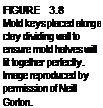
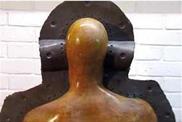 must be sculpted or drilled/routed to make sure that the two halves of the mold will fit
must be sculpted or drilled/routed to make sure that the two halves of the mold will fit
together correctly.
When the second sculpt is completed, a second mold must be made. This results in two pieces of a mold: a positive of the original lif – ecast and a negative of the lifecast with the prosthetic sculpted in.
After the sculpted clay is completely removed and the two halves of the mold are thoroughly cleaned, the prosthetic material— foam latex, gelatin, or silicone—is added (poured, brushed, or injected) into the two-part mold and the mold is clamped tightly shut and the material cures, creating the beginning of a special makeup effect.
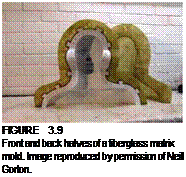 When the appliance is removed from the mold, trimmed, gently washed, and dried (only if it is foam latex), it is ready to be prepainted and applied. Airbrush has become the preferred method (for many artists, but certainly not all) for painting appliances in the 21st century, allowing even opaque material such as foam latex to be painted with numerous layers of transparent pigment to give the impression of the translucency of human skin.
When the appliance is removed from the mold, trimmed, gently washed, and dried (only if it is foam latex), it is ready to be prepainted and applied. Airbrush has become the preferred method (for many artists, but certainly not all) for painting appliances in the 21st century, allowing even opaque material such as foam latex to be painted with numerous layers of transparent pigment to give the impression of the translucency of human skin.
